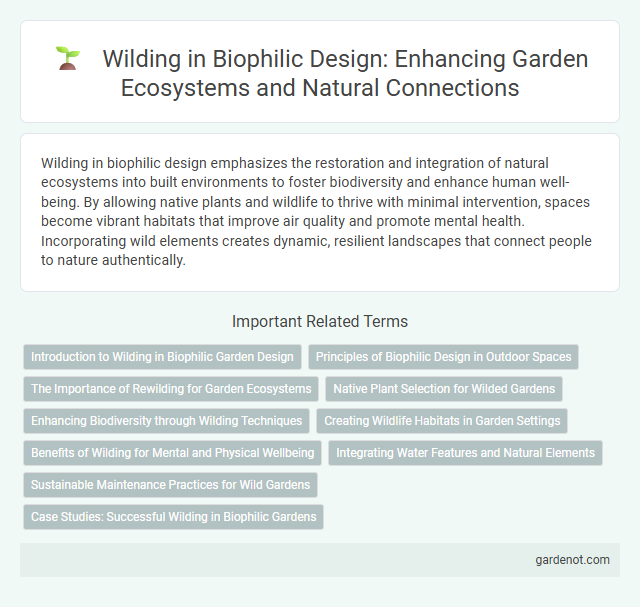Wilding in biophilic design emphasizes the restoration and integration of natural ecosystems into built environments to foster biodiversity and enhance human well-being. By allowing native plants and wildlife to thrive with minimal intervention, spaces become vibrant habitats that improve air quality and promote mental health. Incorporating wild elements creates dynamic, resilient landscapes that connect people to nature authentically.
Introduction to Wilding in Biophilic Garden Design
Wilding in biophilic garden design emphasizes reintroducing native plants and natural ecological processes to urban and suburban landscapes, fostering biodiversity and resilience. This approach enhances ecosystem services by creating habitats for local wildlife and promoting soil health through native vegetation. Incorporating wilding principles supports mental well-being by reconnecting people with nature via authentic, untamed green spaces.
Principles of Biophilic Design in Outdoor Spaces
Wilding in outdoor spaces emphasizes reconnecting built environments with native ecosystems, fostering biodiversity and natural processes. Key principles of biophilic design include integrating indigenous plant species, creating habitats for local wildlife, and promoting dynamic natural patterns like seasonal changes and natural light variations. This approach enhances ecological resilience while improving human well-being through immersive nature experiences.
The Importance of Rewilding for Garden Ecosystems
Rewilding enhances garden ecosystems by restoring native flora and fauna, which improves biodiversity and supports pollinators vital for plant reproduction. This process fosters ecological resilience, enabling gardens to better withstand pests, diseases, and climate variability. Integrating wilding principles in biophilic design reconnects people with nature, promoting mental wellbeing through immersive natural experiences.
Native Plant Selection for Wilded Gardens
Native plant selection in wilding supports biodiversity by providing habitat and food sources for local wildlife, enhancing ecosystem resilience. Wilded gardens using indigenous species reduce maintenance needs, conserve water, and promote soil health through natural nutrient cycling. Emphasizing regional flora fosters a sustainable connection between urban spaces and the surrounding natural environment.
Enhancing Biodiversity through Wilding Techniques
Wilding techniques enhance biodiversity by restoring natural habitats and allowing native species to flourish without intensive human intervention. This approach promotes ecological resilience through rewilding processes, such as reintroducing native plants and animals, which supports complex food webs and increases species richness. Emphasizing wilding within biophilic design connects built environments with thriving ecosystems, improving urban biodiversity and fostering sustainable coexistence.
Creating Wildlife Habitats in Garden Settings
Wilding in garden settings involves transforming traditional lawns into diverse, native plant-rich habitats that support local wildlife such as pollinators, birds, and small mammals. Incorporating features like native wildflowers, berry-producing shrubs, and water sources fosters biodiversity and enhances ecosystem resilience. Emphasizing organic soil management and minimal chemical use further promotes a thriving, sustainable environment aligned with biophilic design principles.
Benefits of Wilding for Mental and Physical Wellbeing
Wilding enhances mental wellbeing by fostering a deeper connection with natural ecosystems, reducing stress and improving mood through immersive green spaces. Exposure to biodiverse environments supports physical health by encouraging outdoor activity, boosting immune function, and promoting restorative sleep. Incorporating wilding principles into biophilic design creates resilient, healing spaces that optimize both psychological and physiological wellness.
Integrating Water Features and Natural Elements
Wilding in biophilic design emphasizes integrating water features such as ponds, streams, and waterfalls to enhance biodiversity and create natural soundscapes. Incorporating native plants and organic materials supports local ecosystems and promotes a seamless connection between indoor and outdoor environments. These water elements improve air quality, regulate temperature, and foster mental well-being by providing calming sensory experiences.
Sustainable Maintenance Practices for Wild Gardens
Sustainable maintenance practices for wild gardens in biophilic design emphasize minimal intervention to preserve natural ecosystems and biodiversity. Techniques such as seasonal pruning, organic mulching, and the use of native plant species reduce resource consumption and promote resilience against pests and diseases. Implementing adaptive management strategies ensures that wild gardens flourish with low environmental impact while supporting local wildlife habitats.
Case Studies: Successful Wilding in Biophilic Gardens
Case studies of wilding in biophilic gardens demonstrate significant biodiversity recovery and enhanced ecosystem services through native plant reintroduction and habitat complexity. Notable examples include the High Line in New York, where spontaneous wild plant growth fosters urban wildlife habitats, and the Eden Project in the UK, which integrates wild meadows and native species to restore ecological balance. These projects highlight the effectiveness of wilding strategies in creating resilient green spaces that support pollinators, birds, and native flora within urban environments.
Wilding Infographic

 gardenot.com
gardenot.com